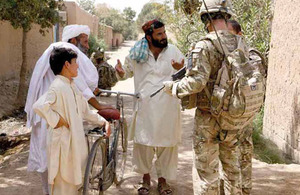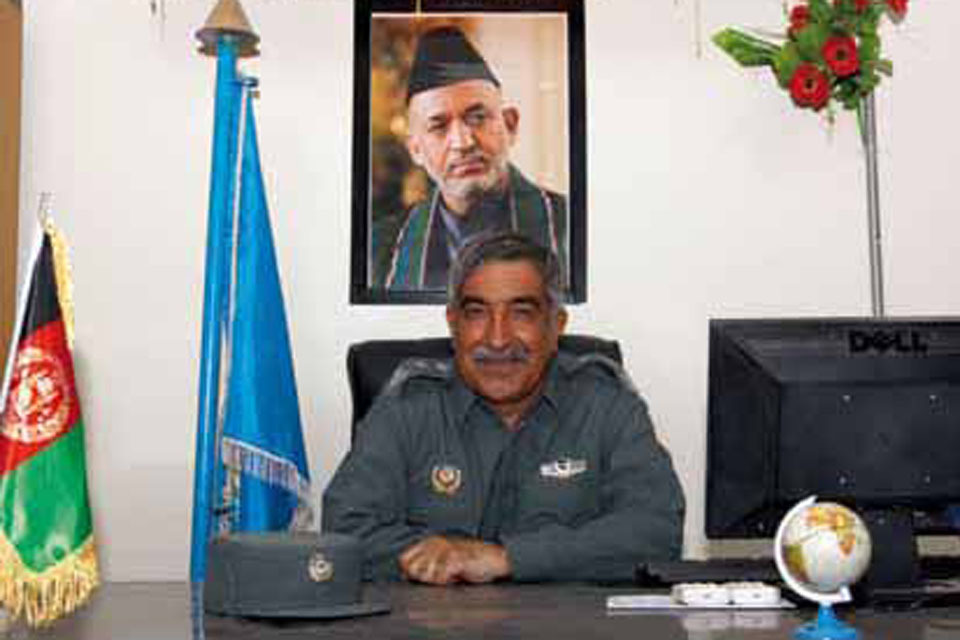The 'unstoppable' peace process in Nad 'Ali
As Nad 'Ali looks to a brighter future, Tristan Kelly reports from the former Taliban stronghold.

Troops from B Company, 2nd Battalion The Royal Gurkha Rifles, stop to chat with some locals from Shin Kalay [Picture: Crown Copyright/MOD 2011]
With a reduction in violence of 86 per cent compared to 2010, the people who live in Nad ‘Ali district, an area once renowned for being a hotbed of the Taliban insurgency, are enjoying unprecedented levels of security.
And now, Afghan President Hamid Karzai has announced that the area, which is to the west of Lashkar Gah in Helmand province and within the British area of operations, will be among the second tranche of areas across the country to begin formal transfer to Afghan security control.
However, today’s relative security has been hard fought and some years in the making. British and other ISAF forces first entered the region in 2006.
Work soon began to disrupt and dislodge the Taliban from the region and in December 2008 a major operation - named SOND CHARA - was launched by British, Danish, Estonian and Afghan forces to clear insurgents from the district centre.
With two patrol bases quickly established, the operation was hailed a success and allowed ISAF and Afghan forces to move out from pockets of security to reassure the local population and offer a platform for stabilisation.
This foothold was expanded over time and culminated in Operation MOSHTARAK in February 2010. Meaning ‘together’ in Dari, Op MOSHTARAK was the largest counter-insurgency operation launched by ISAF forces since entering Afghanistan in 2001.
It involved some 15,000 ISAF troops from the UK, the US, Denmark, Estonia and Canada, as well as large numbers of Afghan troops.
The word ‘moshtarak’ underlined the key feature of the operation - the unprecedented and successful involvement of Afghan forces, including members of the Afghan National Army, Afghan National Police, Afghan Border Police and Afghan National Civil Order Police.

Lieutenant Colonel Shahdi Khan, the District Chief of Police for Nad 'Ali [Picture: Steve Dock, Crown Copyright/MOD 2011]
Speaking on the eve of the operation, Brigadier James Cowan, the then Commander of Task Force Helmand, said:
I can think of no better name to describe this venture. For we are in this together: we have planned it together, we will fight it together, we will see it through together.
Another key feature of the operational plan was ‘seeing it through’ and the Provincial Reconstruction Team and Afghan government departments were involved from the very beginning in bringing governance to the region as soon as the insurgents had been driven out:
We’ve got a government in a box, ready to roll in,” said US General Stanley McChrystal, ISAF commander at the time.
Jumping ahead 18 months and progress in Nad ‘Ali has been stark, with the reduction in violence taking some by surprise. This is particularly true in the southern half of the district, around the district centre.
Speaking at Patrol Base Chili in southern Nad ‘Ali, towards the end of his tour in September 2011, Major Jamie Murray, Officer Commanding B Company, 2nd Battalion The Royal Gurkha Rifles (2 RGR), whose area of operations covered approximately 25,000 of Nad ‘Ali’s population of 75,000-100,000, tells me just how quiet this tour has been:
The summer fighting season has been very much suppressed and the conditions are set for an informal transition,” he said, adding that significant events, such as IED finds and contacts with the Taliban, were down 40 per cent on the previous HERRICK.
And the Taliban, according to the Major, were becoming ‘desperate’, and with that the quality of the enemy had reduced. He cited a recent incident where a suicide bomber had self-detonated in a field a long way from his target in the district centre as a key example.
Major Murray adds that the focus of this tour has been much more on interaction with local Afghans and showing them the benefits of Afghan government control. He also says that there has been a dramatic shift in the attitude of local Afghans since 2 RGR’s previous tour in 2009:
We have conducted 75 shuras so far and each one is convivial,” Major Murray said.
The locals are willing to provide us with information not just about security but about their lives in general - a year ago that shura would have been entirely about security and things to do with life and death.
Now Afghan locals are telling us where bad things are happening, where IEDs are being laid. We now have well over 25,000 counter insurgents in this area, and that is the local people who are countering the insurgency.
The next day I join a routine joint 2 RGR and Afghan National Civil Order Police patrol into the nearby village of Shin Kalay, whose streets and recently restored mosque are buzzing with activity.
The Gurkhas speak freely in Hindi with the villagers and platoon commander Lieutenant Nick Gross is quick to strike up conversation with those in the busy alleyways separating the many compounds.
After a few quick handshakes and nods of recognition, Lieutenant Gross meets with one man he knows well, who explains how his brother has recently returned from the US and is keen to fund the reopening of the local school.
It is a small example of how life is returning to the area as confidence in security takes hold. Major Murray also tells me that local farmers are managing to coax four crops a year out of their fertile soils for the first time in decades.
Not far away, in Nad ‘Ali district centre, the bazaar has increased from the two or three shops of a year ago to over 100 today and the newly-metalled roads are allowing farmers to take their goods to market.
Asked how such a transformation has been achieved Major Murray says that sustained interaction and living amongst the locals, understanding them and what makes them tick, has been crucial.
He is keen to stress though that his men are simply building on the achievements of UK and Afghan troops on previous HERRICKs and the hard work invested in the area over several years.
Carrying the baton into the future will be the sole responsibility of the Afghans. Much of that responsibility will rest with the Afghan National Police (ANP) as the Afghan National Army (ANA) move to more outlying areas to take on the insurgency in the hinterland.
Leading the police from the newly-built District Police Headquarters in Nad ‘Ali is District Chief of Police Lieutenant Colonel Shahdi Khan, who said that he had ever-increasing confidence in his force:
We have enough men now and more importantly we have the trust of the people. When the people trust the ANP we can do anything,” he said.
Despite Lieutenant Colonel Khan’s optimism the quality and quantity of the Afghan security forces will determine the speed of transition and its eventual success or failure.
The issue is being tackled on several fronts, not least in the Lashkar Gah provincial police training centre. Here hundreds of new recruits - and importantly junior officers - are undergoing instruction.
Sergeant Glynn Ross of the Ministry of Defence Police, who has been training junior ANP officers in Helmand, said that while the police in Afghanistan have to know how to fight the insurgency, he is trying to focus heavily on traditional policing skills:
It is part of their mission here to gain the hearts and minds of the people, and if they do that they will be halfway there,” he said. “They are certainly going to be a good police service at the end of the day.
Compared with 18 months ago we are now turning out a much, much higher standard of recruit.
Progress at all levels - from the police to delivering infrastructure projects - has been lauded, and the formal process for transferring security control in Nad ‘Ali is another step on the road to full transition across the country by 2015 when ISAF combat operations will end.
This of course is not the end of the story. UK and other NATO troops will likely continue to offer training assistance to the Afghans after 2014 and Foreign Secretary William Hague has made clear that transition does not mean the end of international support:
The UK remains committed to a strong, long-term partnership with Afghanistan based on diplomacy, trade and development, and support for Afghan National Security Forces’ [ANSF] development,” he said.
General Sherin Shah, the commander of the 6,000 ANA troops that form 3rd Brigade 215 Corps, which cover the key Helmand districts of Lashkar Gah, Nahr-e Saraj, Nad ‘Ali and Gereshk, is bullish in his view of the future:
In Nad ‘Ali the ANSF will take over responsibility for security. The process of transition will take time, and it is not something that will happen overnight, but ISAF troops are not leaving us and will support us if we need it,” he said.
I have seen big changes in Nad ‘Ali in the past few years. Now there are shops, businesses and construction projects happening. Children can go to school to learn. The peace process will continue and nothing will stop us.